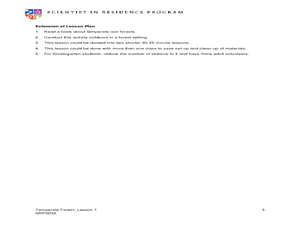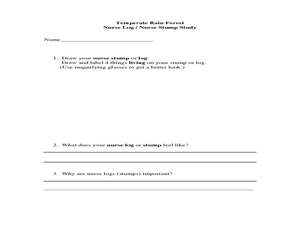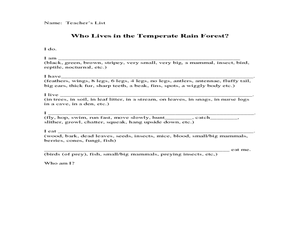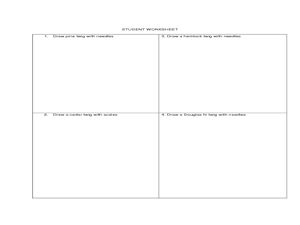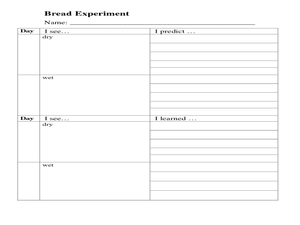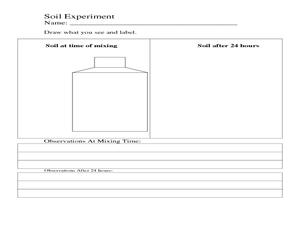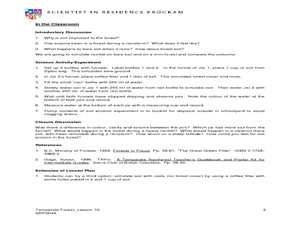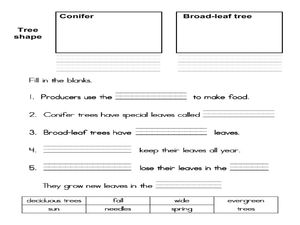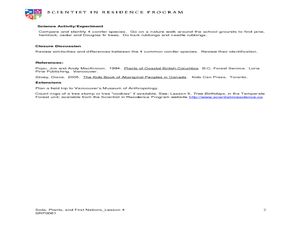Curated OER
Plants 'n' Bugs
Second graders experiment to find if pollinators have color preferences. In this plant and bug lesson, 2nd graders gather information about how flowers pollinate. Students participate in a pollination experiment using the...
Curated OER
Exploring Forest Objects
Students explore the forest. In this ecosystems activity, students rotate through sensory activity centers, brainstorm, and read about temperate forests.
Curated OER
Temperate Forest : Pacific Spirit Field Trip
Young scholars examine nurse logs with hand lenses and identify animals. In this ecosystem lesson, students gain understanding of the rainforest by studying nurse logs. Young scholars become familiar with vocabulary through...
Curated OER
Layers of the Forest
Learners explore rain forests. In this rain forest ecosystems instructional activity, students identify and describe the layers of the rain forest. Learners paint and decorate a large rain forest mural. Students write riddles about...
Curated OER
Trees and Erosion
Students examine the connection between trees and erosion. In this erosion lesson students experiment with the effects of rain on a hillside. Students investigate the number of trees and the amount of erosion.
Curated OER
Comparing Deciduous and Evergreen Trees
Students investigate nature by identifying different plants and trees. In this environmental field trip, students participate in a British Columbia expedition in which they identify cedar, pine, hemlock and Douglas fir trees. Students...
Curated OER
Forest Decomposition
Students explore decomposition. Students define and describe components of the decomposition process. Students make a composter in a terrarium. Students record observations and changes weekly, drawing conclusions about the results...
Curated OER
Under Our Feet
Students investigate the forest ecosystem to learn of the living and non-living elements of the soil. In this ecosystem lesson, students examine soil for twigs, moss, fungi, leaves, roots and other matter. Students...
Curated OER
Forest Food Chains and Webs
Students explore forest ecological systems. In this ecology lesson plan, students classify forest plants and animals according to their ecological roles. Students play a related vocabulary guessing game. Students choose a card on...
Curated OER
Forest as a Filter
Students experiment using soil and water. In this forest as a filter lesson, students identify the role of forest cover, vegetation, and foliage impacts erosion and evaporation. Students conduct a simple experiment, form a hypothesis,...
Curated OER
Dissecting Owl Pellets
Students dissect owl pellets. In this dissecting owl pellets lesson, students discuss birds of prey and make predictions about what they may find during the investigation. Students tease out skull and bones and try to make a complete...
Curated OER
Pond Life
Students recognize the habitats of animals that live near or in a pond. In this pond lesson, students examine pond water and look for pond organisms. Students observe organisms with a loupe and complete a worksheet.
Curated OER
Forest Ecosystem
Learners become familiar with the temperate rainforest. In this forest ecosystem activity, students identify the producers, consumers and decomposers in the forest ecosystem. Learners sort cards and identify the trophic level...
Curated OER
Producers -- Focus on Trees
Students examine the needs of trees and plants. In this forest ecosystem lesson plan students use seedlings to investigate the basic necessities of plants. They discuss the consequences of these basic needs not being met.
Curated OER
Forest Ecosystem
Students take a field trip and explore a temperate rainforest. In this rainforest lesson plan, students discuss many items they see on their journey and experiment with different tree leaves.
Curated OER
Parts of the Flower and Pollination
Students review the parts of the plant and recognize the parts that are important for pollination. In this pollination lesson, students illustrate and label the parts of a flower. Students compare different types of flowers.
Curated OER
Western Red Cedar
Students explore the First Nations uses of the Western Cedar tree. In this nature activity students compare and identify four conifer species. The students go on a nature walk.
Curated OER
First Nations Plants and their Uses
Students identify the uses of plants by researching Native Americans. In this First Nations culture lesson, students identify the First Nations coastal people of British Columbia and their use of plants such as seaweed, bark and moss....
Curated OER
Beach Life: Clam Dissection
Students investigate clams. In this clam life lesson, students conduct an experiment where they dissect clams. Students compare anatomies of humans and clams.
Curated OER
Beach Life: Spanish Banks Field Trip
Students discover beach life. In this beach life lesson, students visit a beach to find plant and animal species that live there. They discuss the life cycle and needs of some of these animals through a variety of activities.
Curated OER
Food Webs and Making Miniature Ecosystems
Students model a food web and create a miniature ecosystem. In this animal interactions lesson, students engage in a role playing game which simulates a food web. Students then build miniature ecosystems using pop bottles, snails, plants...
Curated OER
Modeling changes to Ecosystems Part 1
Students record changes in an ecosystem. In this science lesson students make a hypothesis about changes in a terrarium. They record their observations. The students conduct an experiment to test their hypothesis.
Curated OER
Stanley Park and Aquarium Field Trip
Students explore the beauty of British Columbia by participating in a class field trip. For this ecosystem observation lesson, students investigate the Vancouver Aquarium and Stanley Park, one of the largest parks in North America....
Curated OER
Models as Tools for Ecosystem Management
Fifth graders explore the concept of environmental management. In this ecosystem lesson plan, 5th graders discover how models help scientists learn more about managing ecosystems. Students create their own model, make observations...



